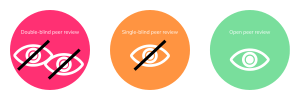A guide to peer review

What is peer review?
Peer review is the process where a panel of experts, relevant to the author’s field of research, evaluate and comment on a manuscript before publication. This is to ensure that research articles are maintaining high levels of quality, validity and a certain level of originality. The peer review process has always been an important part of the scientific journal publication process and, despite many criticisms about peer review’s integrity, is regarded by the research community as the best form of evaluation [1].
Ethical guidelines for peer reviewing
The Committee on Publication Ethics (COPE) lays out key guidelines for reviewers, as the peer review process relies on people behaving responsibly and ethically. Journal publishers are responsible for providing transparent policies for peer review and reviewers are held accountable for conducting reviews in an ethical manner. To learn more about the general guidelines, read the full document here. To learn more about Future Science’s guidelines, check out this link for more information [2].
Types of peer review
There are many different types of peer review, and the advantages and disadvantages of each depend on the varying attitude to openness. Single-blind reviews are the most common form, but publishers do vary in the methods they take to peer review, especially in response to the constantly changing needs of the academic community.

- Single-blind peer review: the author is not made aware of who the reviewers are, but the reviewers know the author’s identity.
- Double-blind peer review: neither the author nor reviewers know who each other is. Full anonymity is maintained.
- Open peer review: both the author and the reviewers are aware of each other’s identity. In some models, the reviews are published alongside the research paper.
These are the three main forms of peer review, there is a fourth form – post-publication peer review – which is uncommon but involves reviewing the manuscript after being published [3].
Top tips for responding to reviewer comments
- Be professional and polite – despite criticism, always be respectful of a reviewer’s comments. If you disagree with a revision, clearly outline your original intentions and reasonings so you may discuss how the article may move forward from this disagreement.
- Respond to all queries and instructions laid out by the Editor, as publishers require authors to follow formatting and other guidelines on resubmission.
- When responding to comments, make sure you provide clear, thorough responses that the reviewer and journal Editor can understand [4].
If you would like to be a peer reviewer for Bioanalysis, please get in touch with our Journal Editor, Jack Lodge [email protected], with a copy of your CV and details of the topics you are interested in reviewing.
References
- Wiley’s Author services, https://authorservices.wiley.com/Reviewers/journal-reviewers/what-is-peer-review/index.html
- COPE, https://publicationethics.org/node/19886
- Cambridge University Press Author Hub, www.cambridge.org/core/services/aop-file-manager/file/5a1eb62e67f405260662a0df/Refreshed-Guide-Peer-Review-Journal.pdf
- Cushman M. How I respond to peer reviewer comments. Res Pract Thromb Haemost. 7(2), (2023) doi: 10.1016/j.rpth.2023.100120





